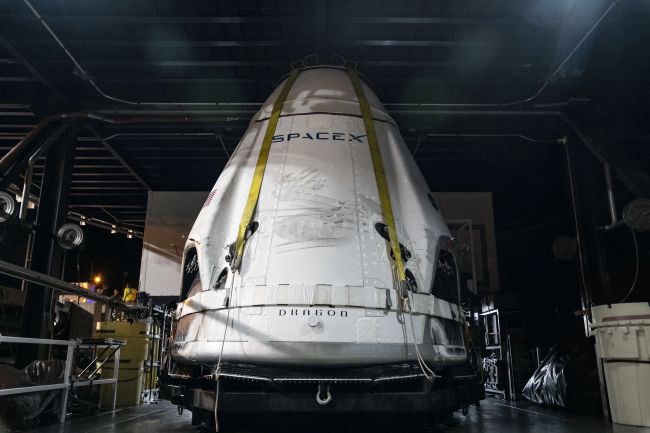This Sunday, January 19, 2020, after multiple weather-related delays, SpaceX was able to launch a 3-time used Falcon 9 from Kennedy Space Center’s launch pad 39A. Atop this rocket was a Crew Dragon capsule containing two mannequins and a whole lot of sensors. This wasn’t a normal launch; this was the inflight abort test many of us have been waiting months to see.
Less than 2 minutes after launch, and after sustaining Max Q (that point in flight when the rocket experiences maximum dynamic pressure), SpaceX had their Falcon 9 just… turn off. This had two effects. As planned, on board software correctly processed sensor and system data to recognize the problem, and released the Dragon Crew Capsule and fired its Draco Engines to get it the hell out of there. The next thing that happened was the unpowered and now unstable rocket, as planned, exploded in a very dramatic way. The jettisoned capsule accelerated away with a maximum acceleration of 3.4 g. This is significantly easier on the body than what astronauts experienced during a necessary abort of a Soyuz capsule in October 2018.
After the Crew Dragon reached a maximum altitude of around 25 miles or 40 km, the capsule began its safe journey home, with all parachutes deploying as planned, concluding with a safe splashdown into the ocean. This successful test prepared the way for a crewed launch sometime this year.
In a press conference following the abort test, there was a clear attempt to maintain a single narrative between NASA administrator Jim Bridenstein and SpaceX CEO Elon Musk; Musk even stated they’d agreed on messaging prior to appearing, roughly 15 minutes late, on the press conference stage.

Musk made it clear that SpaceX should have hardware delivered by the end of February or at worst early March, and ready for launch shortly thereafter. Bridenstein, on the other hand, stressed the desire for additional tests of the parachute system on the Crew Dragon, and said that NASA is going to be rethinking how to use this new hardware. Specifically, they will consider if they’d like to change their current plan to have a short mission to the ISS, and instead have the astronauts stay for an extended period. That latter option would require additional astronaut training, and would delay launch by an unknown amount of time. Many of us wonder why NASA didn’t already provide training for both kinds of missions — long or short — and some question if this is a delaying tactic to allow Boeing and its Atlas launched Starliner a chance to catch up in development (recall they had an unsuccessful trip to the ISS in December).
Bridenstein was extremely clear that NASA wants to have multiple suppliers of human space launch services, and continues to publicly back Boeing and United Launch Alliance. In December, when our Daily Space team visited Kennedy, we found that the information given during facility bus tours actually stressed these older companies and talked about how it would be Boeing that returned Americans to space from American soil. Since NASA is a government funded agency, there are complex politics behind every public message — messages often designed to keep the congress people who write the budgets happy. As we watch the similarly politically motivated actions in the following months, we will be playing close attention to see if Boeing is required to put their capsule through the same tests and experiences the same timeline delays as we’re seeing for SpaceX.
I am a fan of a take it slow, test everything, and move forward boldly kind of approach, but we want to see fairness in how these two companies are allowed to advance their technologies.
Let’s look at the facts: SpaceX has had a successful launch to the ISS, numerous successful parachute tests, pad abort tests, and now a successful mid launch abort test. They are being asked for potentially more testing of their parachutes. On the other side, Boeing had a parachute not deploy during their on-the-ground abort test, and announced that landing on 2 of 4 parachutes was deemed a success and their schedule would not be effected. They also had an unsuccessful launch to the ISS that is being called a success because they had their capsule return to Earth just fine. Currently, we see plans for a June 2020 launch with three people, and a subsequent launch planned with 4 people in December. These 7 humans will each cost more to launch on these Boeing capsules than they would cost to launch in the proven Russian Soyuz capsules.
SpaceX? While all flight-tests have so far been successful, they did have a fuelling accident related to an engine test that resulted in the loss of the capsule originally planned for this weekend’s in-flight abort test. Their parachutes have consistently worked, they have consistently flown to the ISS, and the Falcon 9 rockets are showing they can fly over and over from location after location. Currently, we see plans for a possible April launch with 2 astronauts, but NASA is saying this could be delayed. We also see plans for a July launch with 3 astronauts and no other flights planned for 2020. These 5 astronauts will launch at a substantially lower cost than what is currently being spent on Soyuz capsules.
Currently, NASA has orders in to fly astronauts on 6 additional Starliner and 6 additional Crew Dragon capsules in 2021 and beyond. In the coming months, I hope to see both companies included side-by-side in discussions of our nations’ reborn human space program. I hope see the same tests from both companies, and discussions on how to get costs under control. I hope for fairness. I hope, but I’m not optimistic, but I will be here watching and reporting on what we see happen.




I’m so happy with the content. Keep it up
I’m so glad that I’ve encountered this website. This is so cool! stovetop repair Edmonton
We just need to wait for the result of the space race in order to be certain of its impact but I had high hopes for SpaceX. I invite you guys to visit our website (if interested).
That’s great to know. https://cincinnatiseo.org/
Seems fair to me. It was a great show for sure.
This article touches on the politics behind NASA’s support for multiple suppliers of human space launch services, including Boeing and United Launch Alliance, and the need for fairness in allowing both companies to advance their technologies. https://www.excavatingcincinnati.com
Thank you so much to writing this wonderful blog. It’s really worthwhile.
Tree Service In Richmond VA
The article discusses SpaceX’s successful in-flight abort test of the Crew Dragon capsule, a major milestone towards the company’s goal of launching humans into space. The article also discusses the differences in approach and progress between SpaceX and Boeing, the two companies contracted by NASA to provide human space launch services. While SpaceX has had multiple successful tests and launches, Boeing has faced setbacks, including a failed launch to the ISS and a parachute malfunction during a ground test. The article emphasizes the need for fairness in the testing and developing both company’s technologies and hopes to see them included side-by-side in discussions of the nation’s human space program. portfolio
The article emphasizes the need for fairness in the testing and developing both company’s technologies and hopes to see them included side-by-side in discussions of the nation’s human space program
“Excellent blog post, keep up the great work
Tree Removal Calgary“
This article is special. Thanks for working so hard on it. Wordle Unbegrenzt
More like the Space X race, now. Looks like India is also making a push.
I don’t think it’s not, not fair. But I’m also open to companies getting rights to pursue space exploration and infrastructure. It has to happen because it increases productivity and volume.
“Such a well-researched and informative piece.
Tree Services“